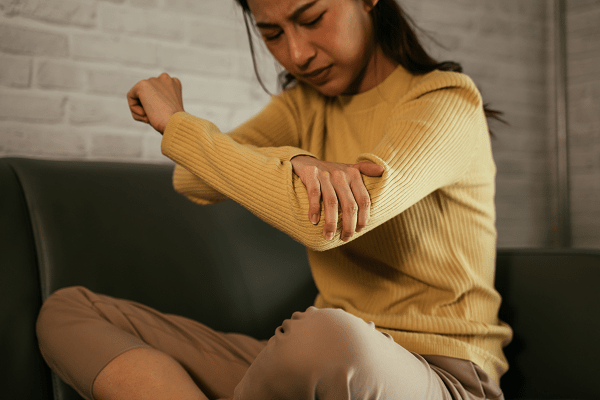Online Enquiry Form

Overview
Radial head fractures of the elbow most commonly affect women between the age of 30-40 years and account for up to 20% of all immediate onset elbow injuries. The radial head is found in the elbow at the end of the radius forming stability of the elbow joint and allowing rotational movement of the forearm. Commonly caused by falling onto an outstretched hand used to break the fall, radial head fractures may be categorised into 3 types of injury according to their severity.
Type I Radial Head Fractures
Very small fractures which do not cause the bone to break apart.
Type II Radial Head Fractures
Cause minimal displacement of small fragments of bone from the fracture site.
Type III Radial Head Fractures
Cause major displacement of multiple fragments of bone which cannot be reduced for healing.
Symptoms
A radial head fracture at the elbow may exhibit the following symptoms:
- Severe pain at the front of the elbow.
- Associated clicking and grinding with elbow movement.
- Loss of elbow movement.

Causes
A radial head fracture at the elbow may be caused by:
- Breaking a fall with your hand.
- Falling awkwardly on an outstretched arm.
The elbow is typically a non-weight-bearing joint, which means direct impact injuries often lose their force as the arm moves with the impact. This situation changes, however, when a fall to the ground is interrupted by reaching out with the arm to break the fall. When this occurs, the elbow can no longer dissipate the impact force travelling through the arm and a break may occur at the radial head at the elbow.
Sports like netball, horse riding, hockey and volleyball can cause elbow fractures due to the nature of the falls sustained.
Trips and falls at the workplace often result in radial head fractures at the elbow. when working in busy restaurants, at events, in hospitals, and on the road as sales reps can increase your chances of sustaining a radial head fracture at the elbow.

Diagnosis
To diagnose a radial head fracture at the elbow, the following will be taken into consideration:
- Understand the nature of the injury (sports, work, accident, overuse etc).
- Determine the cause of the injury (impact, collision, fall, repetitive/slow onset).
- Understand the context of the suffering (age, return to sport, work, impact on daily living).
- Perform a physical examination to ascertain pain and stability.
- Perform specialised elbow shoulder tests to confirm diagnosis.
Radial Head Fracture at the Elbow
A radial head fracture at the elbow will present with the following positive signs:
- Injury caused by a fall onto an outstretched arm.
- Xray confirming radial head fracture.
- Painful and swollen over the radial head of the patient.
- Elbow weakness bending and twisting the elbow.
Some Type I radial head fractures at the elbow do not appear on an xray. It is important to perform a thorough examination of the elbow, to ascertain an accurate diagnosis.

Treatment
Treatment of a radial head fracture at the elbow should always begin with a thorough diagnosis of your condition to understand the severity of the condition in the context of your age, your sport, your work and your life.
Non-Surgical Treatment
Type I and type II radial head fractures at the elbow may be treated conservatively (non-surgically) with immobilisation, rest, pain and anti-inflammatory medication and with physiotherapy treatment after 6 weeks of immobilisation for improved strength and better elbow function.
Surgical Treatment
Type III radial head fractures are indicated for surgery and will require open reduction internal fixation (ORIF surgery).
If a fractured elbow (radial head) is too badly displaced or separated, it may not be able to be repaired and a radial head replacement may be necessary. The goal of radial head replacement surgery is to replace the fragmented radial head at the elbow with a prosthetic one.
Radial Head Replacement
Dr Gupta will choose between radial head prosthesis composition:
- Cobalt chrome, heavier with longer clinical data.
- Pyrocarbon, lighter with strong recent results.
Your elbow is opened from the front side of your forearm and the fractured radial head is removed. Depending on the selected prosthesis, your broken radius will be sized and an artificial one put back in its place.

Post Operative Rehabilitation
You will achieve the best surgical outcome if you follow up surgery with a matching course of rehabilitation. Following surgery, Dr Gupta will outline the most appropriate rehabilitation protocol for your physiotherapist to follow and communicate with your healthcare team to ensure that you receive the best post-operative treatment.
Please contact our friendly team on 02 9687 8344 or make an online enquiry here.

Dr Manish Gupta | MBBS FRACS FAOrthoA
Dr Manish Gupta is a renowned expert surgeon in the field of orthopaedic surgery specialising in upper limb including shoulder, elbow and wrist.